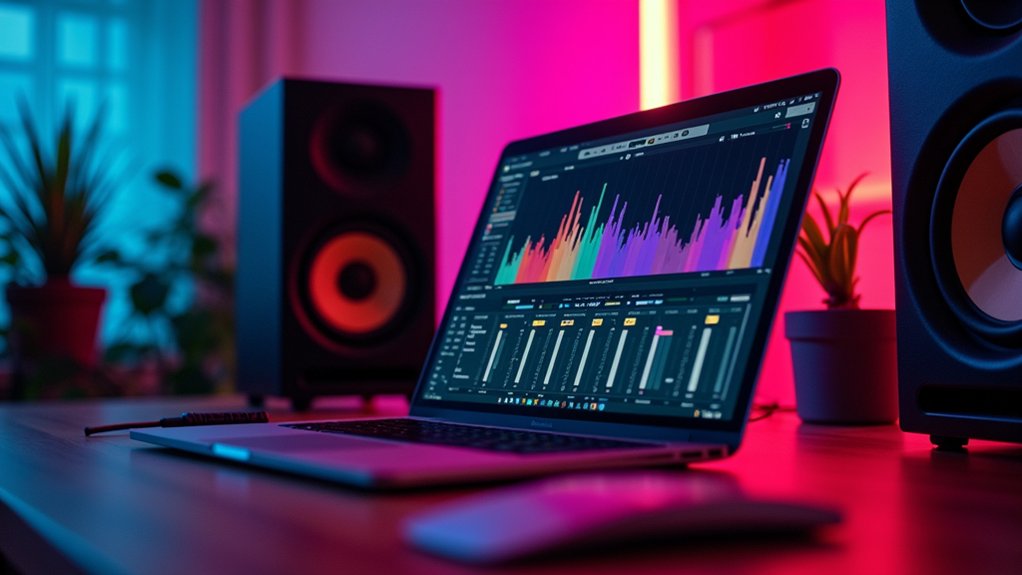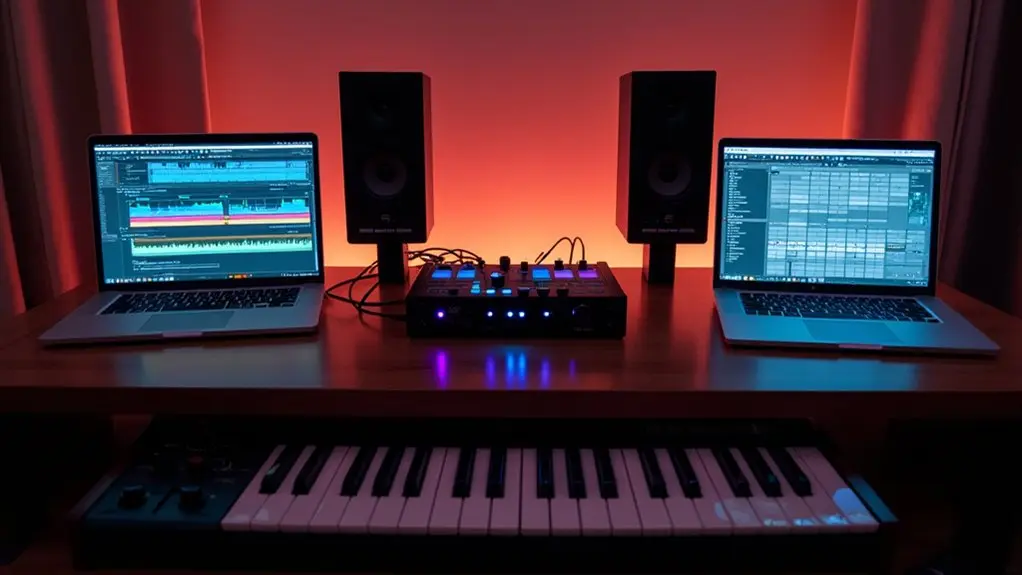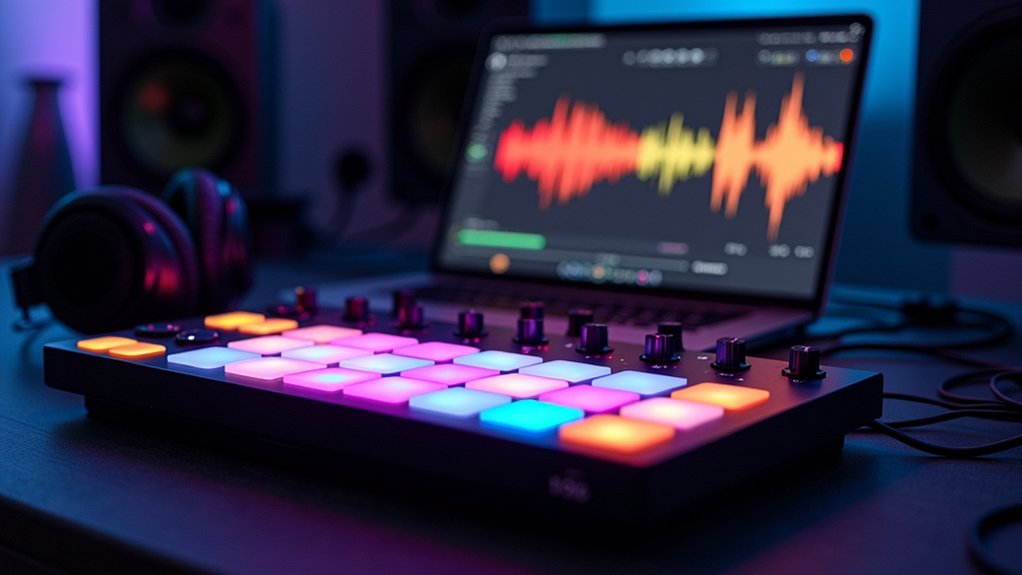Ableton Live users can apply autotune by loading the native Auto Shift device or third-party autotune plugins onto a vocal track. They select the song’s key and scale, then adjust correction strength and smoothing for natural or robotic results. Fine-tuning parameters like formant shifting and using MIDI input release unique effects. Workflow typically includes combining pitch correction with effects such as reverb to enhance depth. Further techniques and creative possibilities await in subsequent sections.
Key Takeaways
- Install your chosen autotune VST plugin in Ableton’s VST folder and rescan plugins in Ableton’s Preferences menu.
- Insert the autotune plugin onto your vocal or monophonic audio track by dragging it from the Browser.
- Set the correct song key and scale in the plugin to ensure accurate pitch correction.
- Adjust parameters like correction strength, retune speed, and formant shifting for natural or creative vocal effects.
- Combine autotune with effects such as reverb or delay to enhance the processed vocal sound within your mix.
What Is Autotune and How Does It Work in Music Production
Autotune, a pitch correction software initially developed by Antares Audio Technologies in 1997, operates by detecting a vocal signal’s pitch in real time and adjusting it to align with the nearest note within a predefined musical scale.
In music production workflows, AutoTune in Ableton Live is typically inserted as an audio effect on a vocal track. The plugin analyzes incoming audio, then shifts out-of-tune notes according to user-defined parameters such as scale type, key, and retune speed.
Producers utilize AutoTune in Ableton Live to achieve precise pitch correction, transparent tuning, or creative effects like robotic vocals. For example, setting a fast retune speed yields the iconic “T-Pain” effect, while moderate settings provide subtle, transparent correction.
This flexibility supports both corrective and expressive vocal treatments.
Exploring Ableton Live’s Native Auto Shift Plugin
While traditional pitch correction plugins often require third-party solutions, Ableton Live’s native Auto Shift plugin streamlines pitch adjustment directly within the DAW environment.
Auto Shift is optimized for monophonic material, making it ideal for vocal processing. Users can select from major, minor, or custom scales, ensuring pitch correction matches the musical context.
The Correction Strength parameter offers granular control over how tightly vocals adhere to the chosen scale, suiting both transparent and stylized correction. The Smooth control further refines results, allowing for either natural pitch shifts or the iconic robotic autotune sound.
Advanced features include Formant Shifting, which manipulates the vocal timbre without altering pitch, and MIDI Mode, enabling real-time pitch correction based on incoming MIDI notes, expanding creative and workflow possibilities within Ableton Live. Add break points in the pitch envelope for smooth transitions when automating pitch changes.
Setting Up Auto Shift for Vocal Pitch Correction
Initiate vocal pitch correction in Ableton Live by inserting the Auto Shift plugin from the Audio Effects section onto the desired vocal track. This step integrates pitch correction capabilities directly into the vocal processing chain.
Once the Auto Shift device is added, users can immediately route their vocal input or pre-recorded audio through the effect. This setup is vital for real-time or post-production pitch correction workflows.
Practical application involves monitoring vocal playback to identify pitch inconsistencies and guarantee the signal is being processed. Engineers often solo the vocal track during this stage to focus on tonal corrections without interference from other mix elements.
This foundational setup readies the track for further pitch correction parameter adjustments, such as key, scale, and correction dynamics, which are addressed in subsequent stages.
Configuring Scales, Correction Strength, and Smoothing
With Auto Shift inserted and signal routing confirmed, attention shifts to precise parameter configuration for ideal pitch correction.
Configuring scales is the first step; selecting major, minor, or custom scales guarantees the pitch correction aligns with the vocal’s musical context.
Next, the Correction Strength parameter dictates the intensity of tuning—higher settings produce the recognizable, modern autotune effect, while lower values retain a more natural vocal quality.
The Smooth control further refines the output by governing the change between corrected notes, allowing users to choose between transparent, organic adjustments or sharper, mechanical pitch changes.
For best workflow, consider the following:
- Match the detected scale to the song’s key before tuning.
- Adjust Correction Strength for subtle or pronounced effects.
- Fine-tune Smooth for desired pitch change character.
Creative Applications: Formant Shifting and MIDI Mode
Formant Shifting within Auto Shift enables precise manipulation of vocal timbre, allowing producers to sculpt unique vocal characteristics without changing pitch.
When paired with MIDI Mode, users can trigger pitch correction in real time by mapping MIDI notes, opening up possibilities for live performance control and intricate pitch effects.
Combining these features facilitates experimental sound design, such as creating robotic tones or harmonically rich textures that extend beyond standard autotune correction.
Transforming Vocal Timbre
Although standard pitch correction refines vocal intonation, advanced tools in Ableton’s Auto Shift—such as formant shifting and MIDI Mode—allow for deeper timbral transformation.
Transforming vocal timbre becomes possible by manipulating the formant parameter, which alters the spectral profile of a vocal without changing its pitch. Producers can use this feature to subtly enhance presence or, conversely, create radical, robotic, or gender-bending effects.
MIDI Mode further expands creative control, enabling pitch correction to follow MIDI notes for harmonically complex arrangements.
Workflow enhancements include the use of vibrato LFO and multi-purpose LFO for dynamic modulation, giving vocals evolving textures.
- Adjust formant shifting to morph vocal characteristics for unique tonal identities.
- Engage MIDI Mode to synchronize pitch correction with MIDI input.
- Apply LFOs to introduce expressive movement and evolving timbre.
MIDI-Controlled Pitch Effects
Harnessing MIDI-controlled pitch effects in Ableton Live’s Auto Shift enables precise real-time manipulation of vocal melodies and timbral qualities. By engaging MIDI Mode, users can dynamically map incoming MIDI notes to dictate the target pitches for vocal correction, offering granular control over melodic content during both production and live performance contexts.
This workflow is particularly effective for genres seeking innovative vocal treatments. Formant Shifting, an integrated feature, allows adjustment of the vocal formants independently from pitch, facilitating the creation of unique vocal textures without altering melodic content.
Combining midi-controlled pitch effects with formant shifting, producers can generate distinctive and expressive vocal variations. Practical applications include live harmonization, robotic textures, or genre-specific pitch contours, expanding the creative palette available within Ableton Live’s autotune environment.
Experimental Sound Design
Pushing the boundaries of vocal manipulation, experimental sound design in Ableton Live’s Auto Shift leverages formant shifting and MIDI Mode to reshape vocal timbres and melodic contours beyond conventional correction.
Formant shifting modifies the tonal character of a voice, enabling users to create robotic, ethereal, or even gender-bending effects without impacting pitch accuracy. MIDI Mode facilitates precise vocal tuning by mapping incoming MIDI notes directly to vocal melodies, yielding intricate melodic reinterpretations or creative harmonization on the fly.
Integrating vibrato LFO and multi-purpose LFO injects dynamic modulation, enriching the sound with movement. Combining these features with unconventional scales, correction strengths, and time-based effects opens up unprecedented textures suited for experimental genres.
- Automate formant shift and LFO depth for evolving timbres.
- Trigger MIDI-controlled vocal tuning for custom melodies.
- Layer with reverb/delay for immersive vocal soundscapes.
Integrating Third-Party Autotune VSTs in Ableton Live
When seeking advanced pitch correction or creative vocal processing, integrating third-party autotune VSTs in Ableton Live involves a straightforward workflow. Users begin by installing the desired plugin, ensuring it resides in the appropriate VST plugins folder. Within Ableton’s Preferences, the Plug-ins tab must have “Use VST Plug-In System Folders” enabled for detection. After restarting Live, the plugin appears in the Browser’s “Plug-ins” section, where a simple drag and drop places it on an audio track. The VST’s interface then allows precise adjustment of pitch correction strength, scale, and smoothness. Saving custom configurations as presets streamlines future sessions. Rescanning ensures all installed plugins are recognized and up-to-date, allowing seamless access to the latest tools. The table below summarizes the drag and drop process:
| Step | Action | Result |
|---|---|---|
| Install VST | Place in VST folder | Plugin available to Ableton |
| Enable in Preferences | Activate VST system folders | VST recognized in Browser |
| Drag and Drop | Onto audio track | VST ready for use |
| Adjust Settings | Use plugin interface | Tailored vocal correction |
Enhancing Vocals With Additional Effects
To further shape autotuned vocals in Ableton Live, producers often combine pitch correction with spatial effects such as reverb to add depth and clarity.
Layering delay and modulation effects—like chorus or flanger—introduces rhythmic complexity and sonic movement, enhancing vocal presence in the mix.
For practical application, these effects can be inserted on return tracks or in series after autotune for controlled blending and creative flexibility.
Combining Autotune With Reverb
One proven technique for enhancing autotuned vocals in Ableton Live involves combining Auto Shift with carefully applied reverb.
This workflow boosts the autotune feature by adding spatial depth, making vocals sound more immersive without sacrificing pitch correction transparency. For best results, producers should fine-tune reverb parameters to complement the unique timbre shaped by the autotune effect.
Key steps in this process include:
- Select an appropriate reverb type—Experiment with hall, plate, or room reverb to match the autotuned vocal’s tonal qualities.
- Adjust the wet/dry mix—Maintain clarity by ensuring the autotune feature remains at the forefront, with reverb supporting rather than masking the effect.
- Utilize pre-delay settings—Create separation and presence, allowing the autotuned vocal to articulate clearly before the reverb tail emerges.
Layering Delay and Modulation
Building on the spatial enhancement achieved with reverb, layering delay and modulation effects further refines the character of autotuned vocals in Ableton Live.
In music production workflows, integrating a delay plugin post-autotune introduces depth by adding controlled echoes. A short delay time—typically between 30 to 100 milliseconds—can produce a doubling effect, markedly widening the vocal presence without compromising pitch correction.
Adjusting feedback and the wet/dry mix tailors the delay’s intensity, ensuring it remains supportive rather than overpowering.
Modulation effects such as chorus or flanger, applied after autotune, enrich the timbre and create an immersive soundscape.
For dynamic expression, automating modulation parameters across a vocal performance enables evolving textures, aligning with the track’s progression and enhancing overall vocal impact in the mix.
Tips for Achieving a Natural or Robotic Vocal Sound
Many producers seek either a natural or robotic vocal effect when applying pitch correction in Ableton Live, and this is largely determined by fine-tuning parameters within tools like Auto Shift.
Achieving a transparent, natural vocal sound with AutoTune involves reducing Correction Strength and increasing Smooth to guarantee subtle pitch shifts. For a distinct robotic effect, higher Correction Strength and minimal smoothing create abrupt, quantized notes.
Further tonal shaping can be accomplished by experimenting with different scales or custom note mappings, directly influencing AutoTune’s response.
- Adjust Correction Strength and Smooth parameters to balance between organic and mechanical vocal textures.
- Use Formant Shifting to preserve or intentionally alter the vocal timbre during pitch correction.
- Enable MIDI Mode to trigger real-time pitch changes, adding expressive or unconventional melodic phrasing.
To enhance your music production skills, it’s essential to understand MIDI quantization which refines the timing of performances and aligns notes to a specified time grid, contributing to a polished sound.
Applying Autotune to Instruments Beyond Vocals
Creative flexibility emerges when applying Autotune—such as Ableton’s Auto Shift—not just to vocals but also to monophonic instruments like synthesizers and guitars.
Producers can use AutoTune to impart pitch correction or create unique melodic effects by adjusting the Correction Strength and Smooth parameters, tailoring the intensity and transparency of the effect.
Formant Shifting within Auto Shift further refines timbre, allowing for expressive sound design that can make instruments stand out or blend in new ways.
Utilizing MIDI Mode enables pitch correction to follow incoming MIDI notes, granting real-time control for live performance or creative studio manipulation.
For enhanced depth, Auto Shift can be combined with reverb or delay, integrating pitch-corrected instruments seamlessly into complex sonic environments or experimental arrangements.
Resources for Expanding Autotune Capabilities in Ableton Live
Expanding beyond standard pitch correction techniques, producers seeking advanced autotune workflows in Ableton Live can leverage a variety of additional resources and tools. Tools allow deeper control over vocal processing, pitch manipulation, and creative sound design. For example, Max for Live devices extend Auto Shift’s capabilities, enabling granular pitch tracking or real-time harmonization. Max for Live is a powerful tool that integrates visual programming within Ableton Live, allowing users to create custom audio and MIDI devices for real-time sound manipulation. Third-party plugins such as Antares Auto-Tune and Celemony Melodyne offer extensive pitch correction and graphical editing features, providing flexible alternatives to native solutions. Integrating built-in effects like reverb, delay, and modulation with autotune tools allow for complex vocal layering.
- Explore free Max for Live pitch and harmony devices for advanced vocal effects.
- Incorporate industry-standard third-party autotune plugins for precise pitch control.
- Join Ableton community forums for workflow tips and device recommendations.
Frequently Asked Questions
How to Use Autotune in Ableton Live?
To achieve effective vocal processing, a user inserts an autotune plugin on the vocal track, selects the song’s scale, adjusts Correction Strength and Smooth parameters, and explores advanced features like Formant Shifting for creative pitch correction in Ableton Live.
What Is the Name of the Autotune Plugin in Ableton?
The autotune plugin in Ableton Live is called “Auto Shift.” This vocal processing tool enables pitch correction through scale selection and correction strength settings, streamlining workflows for users aiming to achieve polished vocal performances in both studio and live environments.
Can Autotune Be Used in Live Performance?
Autotune can be effectively utilized in live performance settings, enabling real-time pitch correction and vocal enhancement. Performers integrate plugins like Auto Shift or third-party solutions, utilizing features such as MIDI Mode for dynamic pitch manipulation and creative vocal effects on stage.
Does Ableton Have Stock Autotune?
The current question addresses whether Ableton offers stock autotune for vocal tuning. Ableton Live includes the native Auto Shift plugin, enabling real-time pitch correction workflows on monophonic vocals, with parameters for scale selection, correction strength, and change smoothing.
Conclusion
In conclusion, mastering autotune workflows in Ableton Live involves understanding Auto Shift’s pitch correction parameters, scale settings, and creative modes such as formant shifting and MIDI control. Producers can sculpt vocals with precision, from subtle transparency to pronounced robotic effects, and extend pitch correction to melodic instruments. By chaining additional audio effects and utilizing external plugins, users expand their sound design toolkit, ensuring flexible, professional results that adapt to diverse music production scenarios within Ableton Live’s environment.




